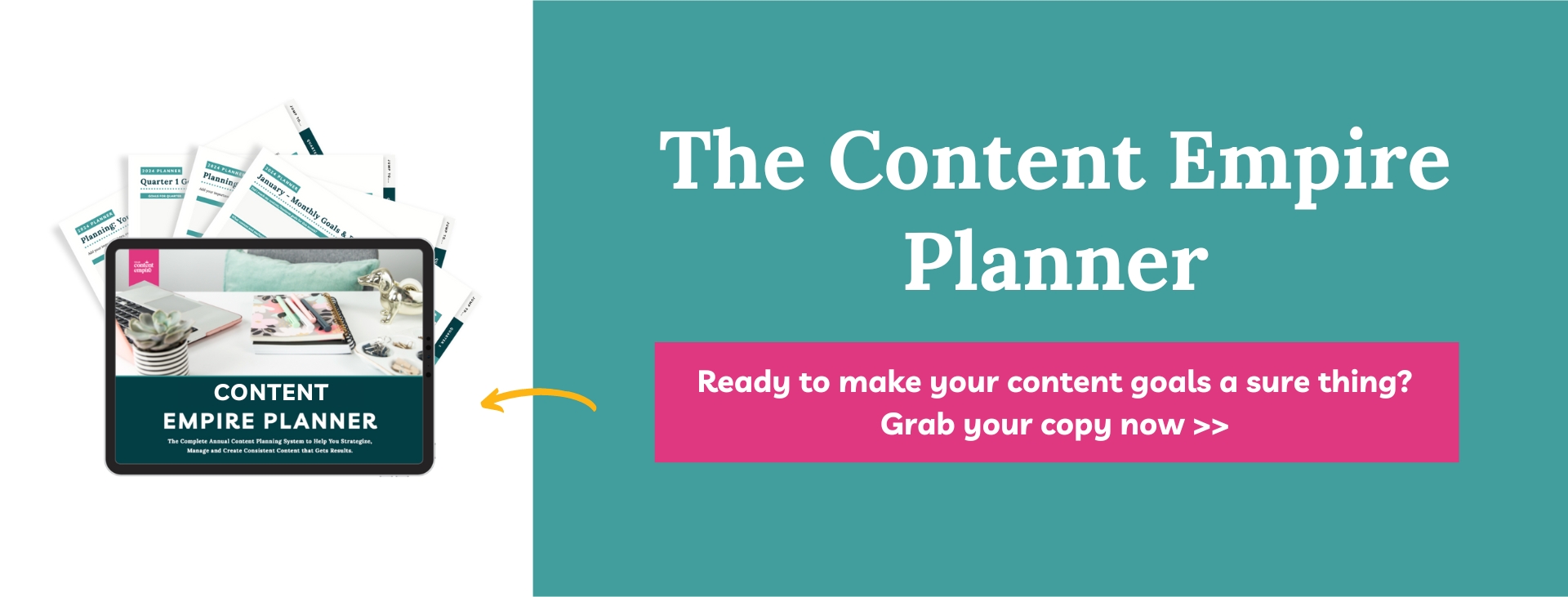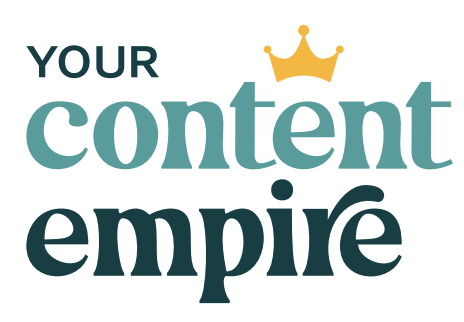It’s almost my biz-versary and so I’m prepping everything to head out for my 2-day solo business planning retreat (start with a 360 Degree Content Audit on day 1). This is an annual tradition—I like to book an Airbnb or hotel so that I can get out of my usual space to plan. Switching up my location helps me be more creative and removes my regular distractions.
The anniversary is right in the middle of November, and as I was in the midst of planning it this year, I thought I’d take you along in the process, in case you’re also planning a business retreat and review to sort out your annual business plan.
In my last post, “Your Ultimate Goal Setting Guide,” I covered how you should approach your goals, especially in light of what’s been happening in this year.
In this post, Part 1 of 2, I’m going to take you through setting the stage for your solo business retreat, diving into a review of 2020 so you can mine it for business and goal ideas.
Let’s get started!
Phase 1: Set the Stage for a Successful Retreat
Know that while you’re on your business retreat, you might want to plan your day a little differently than normal.
I’d recommend blocking out one or two full days for this, clearing out client work, meetings and all other tasks beforehand so that you can dedicate this time to your annual content planning. This is your time to set the direction and review of your business as the CEO!
Planning can seem daunting, so I like to make it fun by rewarding myself for getting through it.
First, I make sure to have all my favourite supplies and snacks around to help me actually get through the days.
Second, I also like to schedule in self-care time, maybe picking a hotel with a spa I can go to, as a reward for accomplishing what I needed to accomplish in my planning.
Then, I like to create my agenda so I can keep myself on track and still leave room for plenty of mental breaks to recharge.
Rather than run away from it, plan things to make this process fun and exciting, thinking about what it is you need to help you stay focused and motivated.
Phase 2: Review and Reflect on Your Past Year
I think I can speak for MANY businesses when I say that last year was not the year we had anticipated. But there are also a lot of lessons we can learn from it.
While on my retreat, I do a really thorough and robust review of my past year, auditing different areas of my business to figure out where I can improve for the coming year.
I look at things like:
- My customer experience
- My brand
- My website
I take the time to slow down and think about the small things I can do to improve these brand touchpoints. If you’ve been in business for a few years then you know that sometimes small tweaks actually have the biggest impact on your business, you just have to actually give yourself the space to identify and then implement them.
Step 1: Sales
Because I do this review process in November, I look at my year-to-date sales, as the year isn’t over yet. I come back and do a second review when the full year is complete.
For this, I’m looking at the total units sold for each offer I have plus the total dollar amount that those represent, and then I’m able to see which offers are my main offers. A.K.A., which brought in the most income.
I also like to look at where my sales came from, and if there was one channel in particular that drove a lot of sales. Last year, for example, I did a podcast episode on my sales funnel process, and it ended up bringing in SO MANY clients for my 1-1 sales funnel package. Without this reflection and review, I never would have noticed that and been able to learn from that for the next year.
After each step, I go through a few reflection questions to wrap it up:
- Were there any surprises?
- Are there any offers I might want to cut or add next year?
- Which of these offers did I enjoy delivering?
Step 2: Sales System
This step is directly related to Step 1, and it’s where I map out my buyer’s journey. I have a few, so I usually only do it for my main offers, whatever is bringing in the most revenue (as we determined in Step 1). If you have the time though, you can definitely do it for multiple offers.
I happen to have two sides to my business, my core site and then the agency side, so I make sure to look at both sides when doing my buyer’s journey.
Here, I’m mapping out:
- Where did they discover us?
- What is their next step?
- How can I do a better job at getting them to the next step?
I’m writing out every point in their journey until they say “yes” and start our onboarding process.
I also make sure to do an audit on my sales funnel system, and I use my sales funnel audit calculator to do this. With my buyer’s journey in hand, I look at each step of my sales funnel and ask myself how could this be better?
I want to know where I can improve in order to increase my close rates so I make the most of the leads I’m getting.
Step 3: Traffic
Sticking to year-to-date again, I look at my traffic, breaking it down by month to define my most popular pages, blog posts, and where the traffic to them came from.
Once that’s down, I reflect on it to see if there are any surprises in my findings:
Maybe my traffic plateaued or decreased at a certain point. Why?
What were my main traffic drivers this year and what would I want to add or switch my focus from next year when it comes to my traffic sources?
Step 4: Social Media
I like to do the basics of a social media analysis, like looking at the total number of followers, total traffic coming from those, and reviewing engagement.
But I also like to give each platform a happiness score. Did I enjoy showing up on this platform, or was it like pulling teeth?
One of my main focuses this year was Instagram, and I can tell you it’s been a bit of a double-edged sword. While I’ve had a lot of growth on the platform, it’s also a platform that I’ve needed to put a lot of work into in order to see that growth and continued engagement. Knowing that I need to decide if the return on investment is really worth it, or if I can take a step back a bit.
With each step comes a reflection section, and here I’ll ask myself:
- What worked this year with my social media and what didn’t?
- What do I want to start or stop?
- What could I make better with the main platforms I’m already using?
- Is there a system or strategy I could try out that could help me grow without increasing my output effort?
Step 5: Brand
I do a spot check on my brand in this phase, seeing how it’s resonating right now, looking at the images and materials we’re putting out and judging if we need to update our brand guidelines. And I also like to do a bit more of a holistic check-in of how well I feel my brand values are getting across and if I need to make any updates.
As we go along, you can see I’m creating almost a to-do list for the start of the coming year, seeing what improvements I can make. You can add this to your quarterly plan, and make sure you’re doing it at the annual level if nothing else, so you know what changes you need to be making to your brand.
Step 6: Website
I usually have one of my assistants go through my website in detail, checking to make sure there aren’t any broken links or images.
It’s almost like a page by page tech check, seeing if any copy or forms need to be updated, changing the date in the footer of my site, assuring my back up system and security are in place, and clearing out any unused plugins, pages, and posts. I also like to have old users removed. All of these tweaks contribute to a better running and safer website.
Step 7: Customer Experience
For my main offers, I look at everything that happens after a customer says “yes” or purchases.
I want to know what questions and feedback I’m getting from clients, because oftentimes if they’re saying the same things over and over again, it means that I need to go in and make things more clear or smooth out kinks.
The biggest improvement you can make to your customer experience is to never leave your customer guessing. If your customer has to ask “what’s next,” then you need to revisit your process so you're answering this question BEFORE they ask it.
Investing in your customer experience can be one of the best MARKETING moves you can make—word of mouth and referrals are invaluable!
Step 8: Systems
I like to do a review on my inventory of my systems at least once a year. I break them down by content systems, marketing, offer fulfillment, CEO. Below each of these is where I’ll look at what we already have in place and what needs to still be created.
Once I have it all listed out (putting Asterix’s beside those that I still need), I take the time to ask:
- Of those systems that need updating or need to be created which will have the most impact on my business?
- Is this system going to save me a ton of time, or improve our customer experience?
Ranking them this way allows me to see which of the systems will have the biggest impact, which is where I will probably choose to invest first.
Step 9: The Team
I review at every single role I have on the team and their responsibilities in this step. I also like to be honest with myself about what I’m doing and where there are opportunities for me to delegate more.
I’m VERY guilty of just doing something myself because I think it will be easier than training somebody, so I look at this step alongside step eight and see who can take on what and what systems they should handle.
This allows me to see who I might need to hire in the following year, who needs more training, and where I can outsource more.
Step 10: Finances
Ah, finances. Every business owner’s favourite topic (Not)!
This is definitely one of the biggest steps, and while you should look at your finances once the year is complete, looking at them up until the year-to-date here helps you to get ahead of planning for next year.
I like to look at my sales, expenses, profit, and tax estimate, looking at the main sources for each this way, I can get a good idea of:
- Any financial surprises
- What expenses I can cut next year
- What investments I want to make next year
This is a good opportunity to make sure that your bookkeeping is up to date.
Step 11: Goals
You’ll notice I’m mentioning goal review so close to the bottom, and that’s because I think you have to look at every aspect of your business before you can have a true assessment of how your goals went.
How often do you think, GOSH! I didn’t achieve that goal like I thought I did. But then a reflection of the numbers shows, actually, you did! This is why I put this near the end.
I look at my yearly goals and see what I’ve achieved so far, and what I might be able to bring close to completion by the end of the year (we’re in November, remember). Maybe there were some surprise goals you didn’t plan for but ended up accomplishing, and if you didn’t reach any goals, why?
Goals don’t have to start and end in one calendar year, and you can choose to carry them over if you wish.
This is a good opportunity to think about ideas for yearly goals, making notes so that you have those to consult later on (like on day 2 or part 2 of this walkthrough guide!).
Phase 3: Complete an Overall Reflection of Your Year
This final reflection is my favourite review, as it really gets me thinking about my business at a deeper level. I start with January, and go through the year month by month, seeing what my highlights were and what lessons were held within each of those months. I’ll even go through my past emails or my Weekly Business Journal to remember exactly what was happening at the time.
Business motivation – I look at my motivation in my business, asking myself:
- Why did I originally start this business?
- Has that motivation changed?
- What do I still love about my business?
Business investment – I move onto my business investment, asking:
- How much am I really working in my business?
- Where am I spending my time?
- What’s my business costing me?
Business ROI – Journaling on all of that, I then move over to my return on investment, asking:
- What am I getting in return from my business?
Business and lifestyle alignment – This leads to alignment, where I reflect on:
- How is my business currently fitting into my lifestyle?
- What does my ideal daily lifestyle look like?
- In this ideal lifestyle, what am I doing in my business on a yearly, monthly, weekly and daily basis?
Do things need to change? – Finally, I move into the pivot section, where I look at:
- What needs to change in order for me to live the lifestyle I want?
- What business changes do I need to make (think: offers, ideal clients, marketing, sales systems, systems, team) to make this lifestyle a reality?
You’ve audited and journaled and reflected, allowing you to be clearer on the goals you want to set for the year ahead. Take some time to celebrate your annual review and reflection of your business!
You can find ALL THE WORKSHEETS that go along with each step of this process in my Content Empire Planner.












